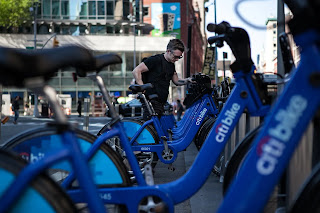If you’ve been reading this blog for a while, you know that one of my pet peeves is bike lanes that put cyclists in more danger than they’d experience in riding on the streets.
Bike lanes can be hazardous in all sorts of ways: They can be poorly constructed or maintained. They can be poorly conceived and designed. (How many lanes begin or end “out of the blue” or lead cyclists straight into the path of trucks or buses turning right in intersections?) Or they can be marked (or not) in ways that confuse motorists and pedestrians as well as cyclists.
The latter situation confronts drivers and cyclists along Lake Avenue on Cleveland’s West Side. Recently, the city installed a bike lane there. What they neglected to do, however, was to remove 30- and 60-minute parking signs.
Not only is it inconvenient for cyclists when motor vehicles pull in and out, or park in bike lanes: it’s also hazardous. “It creates a situation where motorists don’t expect cyclists to veer out into the roadway because there is a bike lane,” explained Jacob VanSickle of Bike Cleveland.
He says BC has contacted the city about removing the signs. The city said it’s the duty of a contractor for the Ohio Department of Transportation to remove the signs. According to Isaac Hunt, the lane is expected to be completed by mid-December and the signs will be gone “in a few weeks.”
“Those are bike lanes now,” Hunt says and cars are therefore not permitted to park in them. But, many drivers are understandably confused by the signs: perhaps they don’t see the bike lane markings or realize they aren’t supposed to park in a bike lane.
Then, of course, there are motorists who resent having “their” road space taken from them, or just don’t care about rules. For them, the rules have to be enforced. For everyone else, those rules—and the very existence of the bike lane—need to be clarified.

